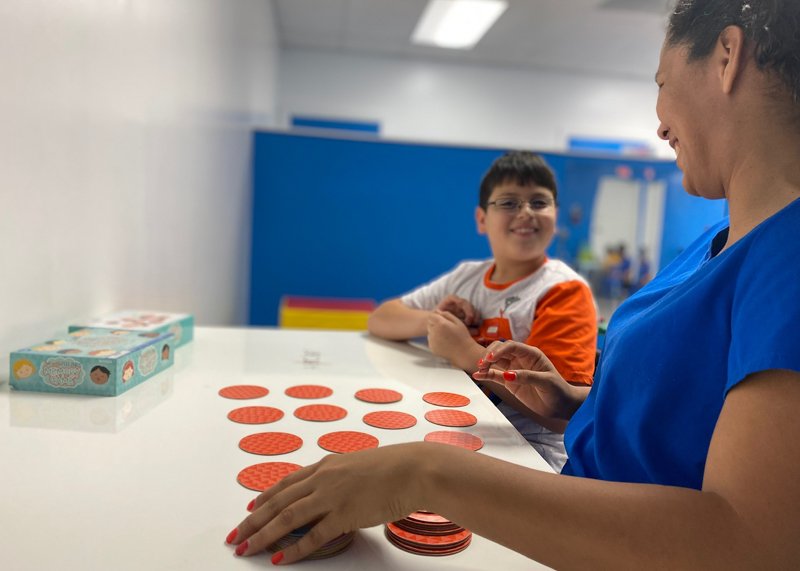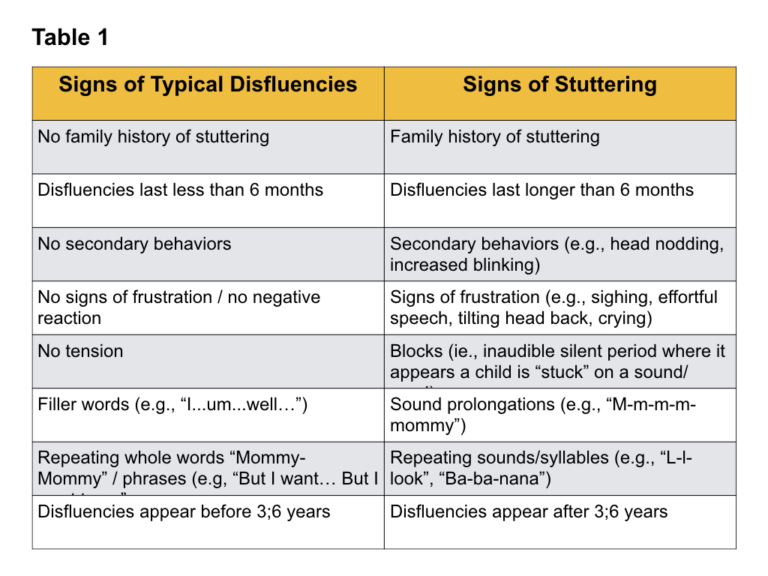What is Stuttering?
Imagine you’re at the ice cream store and you hear the following phrase from a customer: “I want the… I want the um… what’s it called… the chocolate flavor yeah, the chocolate flavor, please” — this is a sentence that represents a disruption in fluency, which is the continuity, smoothness, rate, and effort in speech production. In other words, a disfluency. Everyone displays disfluencies in their speech production.
Now imagine you’re at the ice cream store and you hear this phrase: “I w-w-want the… ch….ocolate” , while the customer simultaneously appears “stuck” on the sounds and words. These signs may point towards a fluency disorder mostly known as stuttering, which is the most common fluency disorder.

Stuttering is an interruption in speech production that involves:
- Repetition of sounds (e.g., “w-w-want”)
- Repetition of syllables (e.g., “cho-cho-chocolate”)
- Repetition of words (e.g., “she-she…”)
- Repetition of phrases (e.g., “I want..I want..I want..”)
- Sound prolongations (e.g., “chocolllllllllate”)
- Blocks (inaudible period e.g., “I w…..ant”)
- Interjections & Revisions
- Additionally, stuttering often involves secondary behaviors, such as:
- Facial grimacing (e.g., frequent eye blinking)
- Head movements (e.g., head nodding)
- Movements of extremities (e.g., tapping leg)
- Avoidance behaviors (e.g., avoiding eye contact, abandoning a phrase due to anticipated difficulties)
- At this time, there are no definitive answers as to why stuttering occurs. However, there are known risk factors including:
- Family history
- Neurophysiological factors
- Child’s sex
- Boys are at an increased risk compared to girls
- Age of onset
- Past 3;6 years
- Co-existing speech-language disorders
Stuttering in Children
In the first few years of life, it is rather common for children to display disfluencies, or interruptions in the normal flow of speech (e.g., “I…I…I…I want that one”), because their brains are building so much vocabulary and processing an array of different sounds. Children are learning a variety of complex language rules, while still developing motor coordination; therefore, it is not surprising if there are disruptions along the way. In fact, about 5% of all children will display typical disfluencies during the preschool years. Some children may even go back and forth between periods of disfluency and fluency. For the majority of children (~75%), the disfluencies go away without treatment.
But what about the remaining 25%? If you are a parent or caretaker of a child, and your child is displaying disfluencies, how do you know when the disfluencies are typical, or if they’re something more? Below please find Table 1, as it may be helpful in depicting signs of typical disfluencies vs. signs of stuttering.

All About Children Stuttering
If you’ve read children stuttering Table 1 and you feel your child is indeed displaying signs of stuttering, a bit of worry may have crept up on you, but that’s completely okay — it simply means you want the best for your child, and by researching alone you are already ahead of the game. A speech-language pathologist can help calm any worries by answering questions during a comprehensive evaluation and determine the best course of action for your child’s needs.
What does treatment look like?
If a speech-language pathologist has diagnosed your child with a stutter, early treatment will be very helpful and beneficial to your child. In particular, early treatment before 6-7 years of age is highly effective.
At Exceptional Speech Therapy, treatment not only involves learning specific strategies to help decrease the stutter itself, but we also ensure that the child gains tools to manage the socioemotional effects of stuttering. One of our main goals is cultivating self confidence within the child.
We are cautious when working with children who stutter so they never feel self-conscious of their stutter, rather they feel that “it’s okay” to stutter. We want them to feel self-assured that they know exactly how to manage it, using specific evidence-based strategies. There are two treatment approaches that are implemented: the indirect treatment approach and the direct treatment approach. Keep reading to see how these both work.
Indirect Treatment Approach →
With the indirect treatment approach, the speech-language pathologist modifies his/her own communication styles, and teaches family members how to modify their communication style. This subtle approach is often effective at reducing or even eliminating stuttering in many young children. Please refer to “Tips for Parents” below, to learn how to utilize them in the home setting to promote successful communication with a child that stutters.
Direct Treatment Approach →
With the direct treatment approach, the child works 1:1 with a speech-language pathologist to learn specific strategies to manage the stutter itself. There are a variety of stuttering modification strategies that help gain self-awareness of the speech mechanism. Examples of some of these strategies are listed below:
- Reduction of speech rate/pausing
- Easy-onset
- Cancellation
- Prolongation of syllables
- Light articulatory contact
- Continuous phonation
The hope is that he/she can learn to identify the behaviors that cause physical tension related to the stutter, and ultimately reduce the tension and modify speech. Over time, the specific strategy that your child chooses to use will also depend on when he/she “catches” the disfluency: following a moment of disfluency, in the moment of disfluency, or in anticipation of a moment of disfluency.
Equally important, there are also strategies to manage any accompanying secondary or negative behaviors, as it is paramount for their socioemotional well being to know that “it’s okay” to stutter. These strategies are often used for older children and adults.
Examples of some of these strategies are listed below:
- Desensitization
- Cognitive restructuring
- Self-disclosure
8 Tips for Parents
- Reduce your own rate of speech →
-
- By reducing your own rate of speech and modeling good speech habits (e.g., pauses, speaking in an unhurried manner), children are more likely to mirror the habits.
-
- Reduce any communication stress →
-
- Although asking questions is natural and encouraged, avoid asking questions one after another, as this may place unintentional pressure on a child in a speaking situation. Instead, comment on what your child is doing.
-
- Practice turn-taking →
-
-
- With family members and other children in the household, it is important for each child to feel “heard”. A child who stutters will find it to be much easier when there are less interruptions.
-
- Practice patience →
-
- Allow ample time to finish their sentences, even if they are stuttering. Interrupting them to “slow down” is generally not helpful, and may cause more stress.
-
- Actively listen to your child →
-
- Give full eye contact when your child is speaking, especially if he/she is stuttering. Convey that you are listening to what your child is saying, and not solely observing the stuttering.
-
- Minimize reactions to stuttering →
-
-
- If you child stutters, minimize reactions to the disfluencies. If parents feel anxious or worried about the stutter, children can feel those emotions, which can create a cycle where the child begins stuttering more because they feel pressure.
-
- Build confidence →
-
- Praise strengths unrelated to talking, in a specific and descriptive way. (e.g., “I really liked how you cleaned your room. You are so helpful.”)
- Additionally, set aside five minutes each day to provide undivided attention to your child. It can be a major confidence booster.
-
- Talk about it →
-
- If your child is aware of the stutter, talk about it. Let him/her know that it’s okay to have a stutter. If your child is not aware of it, however, there is no need to bring it up until a speech-language pathologist has conducted an evaluation.
-
Bilingualism and Stuttering
There are many questions regarding bilingualism and stuttering, especially here in Miami, Florida. Do bilinguals stutter in just one language or all of them? Does stuttering severity correlate to bilingualism? Some commonly asked questions will be answered below:
- Does bilingualism cause stuttering?
No, there is currently no research to support that bilingualism causes stuttering.
- Is stuttering more common in bilinguals?
Currently, there is no evidence to support that stuttering occurs more often in bilinguals.
- Do bilinguals usually stutter in both languages?
Generally speaking, yes. Stuttering is considered a motor disorder, it is mostly observed in both languages. If your child solely stutters in one language, it is likely related to an imbalance between the proficiency level of each language. For example, if your child is judged to be equally dominant in English and Spanish, he/she will likely display stuttering in both languages. If your child is English dominant but learning Spanish, he/she will likely display an increased amount of stuttering in the less dominant language (Spanish).
- Does stuttering portray itself in the same way, in both languages?
The severity tends to differ between languages, according to studies. For example, children stutter more often on content words (e.g., nouns, adjectives, verbs) in their more dominant language, while they stutter on function words (e.g., articles, conjunctions) in their less dominant language.
- Should I speak to my child only in one language?
No. Currently, there are no studies indicating that family members should only use one language in the household to avoid stuttering. It is encouraged to use both languages, if that is what is most natural for the household.
- Should speech therapy be conducted in one language or both?
A bilingual speech-language pathologist should teach the strategies in the more proficient language of the child; however, studies have shown that speech therapy does not have to be treated in both languages for it to be effective. The research has shown that treating a child in one language, will generalize to the non-treated language.
If you suspect your child may be displaying signs of stuttering, please do not hesitate to reach out to Exceptional Speech Therapy to schedule an evaluation with a skilled speech-language pathologist. Feel free to give us a call (786) 717-5649, or e-mail us at info@exceptionalspeechtherapy.com.
Andrea Scola, M.S., CF-SLP
Exceptional Speech Therapy Blog Writer
References:
American Speech-Language-Hearing Association. (n.d.): Childhood Fluency Disorders. Retrieved from https://www.asha.org/PRPSpecificTopic.aspx?folderid=8589935336§ion.
Coleman, Craig (2016). American Academy of Pediatrics and American Speech-Language-Hearing Association. Stuttering in Toddlers & Preschoolers: What’s Typical, What’s Not?. Retrieved from https://www.healthychildren.org/English/ages-stages/toddler/Pages/Stuttering-in-Toddlers-Preschoolers.aspx.
DeTrempe, K., & Digitale, E. (2019, July 10). What One Speech Therapist Wishes You Knew About Stuttering. Retrieved from https://healthier.stanfordchildrens.org/en/speech-therapist-explains-stuttering/.
Lim, V. P. C., Rickard Liow, S. J., Lincoln, M., Chan, Y. H., & Onslow, M. (2008). Determining language dominance in English–Mandarin bilinguals: Development of a self report classification tool for clinical use. Applied Psycholinguistics, 29, 389–412.
National Stuttering Foundation of America (2020). 7 Tips for talking with your child. Retrieved from: https://www.stutteringhelp.org/7-tips-talking-your-child-0?gclid=CjwKCAjwq832BRA5EiwACvCWsSt5xAAjKo7IjCd0kaahOMUiKpHzN6m_nJqP5DoNcy3Ycir5ysc5eRoCLIcQAvD_BwE.
Van Borsel, J. Maes, E., & Foulon, S. (2001). Stuttering and bilingualism: A review. Journal of Fluency Disorders, 26, 179-205.
Contact Us
If you have any questions about speech therapy in Miami or Doral, Florida or would like to book an appointment for speech therapy, please call Exceptional Speech Therapy at 786.717.5649 or fill out the form below.
5 Creative Ways to Wean Your Child off the Pacifier
Ah, the beloved pacifier – the magical tool that soothes fussy babies and saves parents from countless sleepless nights. But, there comes a time when the binky must go, as it can impact a child's oral development, sleep habits, and [...]
What is a Pediatric Sensory Diet?
Today, we will explore an example of a Pediatric Sensory Diet to kickstart your child's sensory adventure! Before we jump into the example, let's remember that every child is unique. A Sensory Diet is a personalized roadmap to support children [...]
A Collaborative Approach to Detecting and Supporting Sensory Challenges in Kids
Hello, wonderful parents! Ever noticed your child's unique reactions to the world around them? Today, we're embarking on a journey to understand and support sensory challenges in kids. In this guide, we'll explore real-life examples, tiny signals that can help [...]


